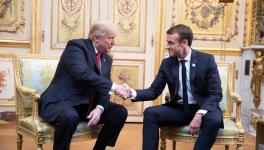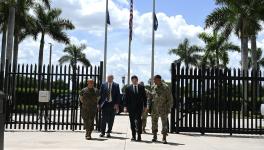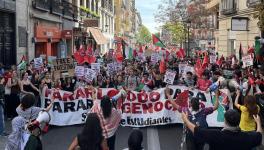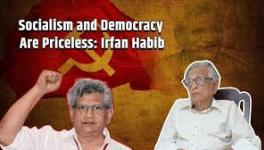Times of Chaos and War

Police crackdown on protesters in Lima, Peru on September 27, 2025. Photo: Juan Mandamiento / Wayka
“The time is out of joint,” Hamlet utters this phrase in a whisper when the ghost of his father reveals the crime that has displaced the kingdom and imposes on him the impossible task of “setting it right again”. It is not a mere phrase, it is a diagnosis of the era spoken at the moment the truth bursts in and the world falls out of sync.
Today, time also seems out of joint: in the framework of the global dispute between the United States and China, the Caribbean is militarized with disciplinary pretensions over the rest of the hemisphere, while a constellation of youth and popular protests spans from Morocco to Indonesia, and from the Andes to the Baltic.
The Palestinian tragedy opens “agreements” over ruins without justice; the war in Ukraine stabilizes into a temporality without armistice; and Europe goes through a cycle of political fatigue that erodes its capacity to set an agenda. Meanwhile Argentina, in the name of stability, decrees the scrapping of sovereignty in a tragicomic display.
The militarization of the Caribbean – with exercises and rapid‐deployment capacities and a “combatting narcotics” discourse that functions more as a pretext than a comprehensive policy – is not a tactical anecdote but a governance of international disorder: a message to Venezuela that, by extension, conditions the whole region.
What is decisive is not only the material presence of aeronaval capacities and special forces, but the normalization of a threshold of legal exceptionality that enables operations of low political traceability and high symbolic potency.
On a regional level, the result is a climate of strategic self-censorship: governments that prioritize bilateral safeguards over multilateral cooperation, and economic and technological agendas that reorder under pressure – precisely at the moment when the dispute over standards (energy, data, connectivity) defines who captures value in the transition underway.
Against that backdrop, the word “genocide” has ceased to be a hyperbole in Palestine, and now names a process of systematic destruction of lives, institutions and territory.
The “agreements” signed or announced in recent months – partial ceasefires, reconstruction arrangements, formulas for transitional administration – appear as architectures of negative peace erected on a human and urban desert: they guarantee neither truth nor justice, they do not ensure safe returns, they do not halt the dynamic of dispossession and collective punishment, and they consolidate a geography of confinement that fractures any horizon of effective self-determination.
Diplomacy, when it omits the minimal triangle of truth, justice, and repair, does not pacify: it freezes the damage and turns humanitarian aid into a device of suffering management.
The continuation of the war in Ukraine, for its part, has institutionalized a European state of emergency and a global war economy. The front remains active in cycles of offensives and retreats without a point of capitulation, with drone technologies that lower the cost of lethality and raise the cost of defense. The temporality of the conflict – months that are already years – erodes political legitimacies in the “free world”, pressures budgets, and reveals the limits of a political architecture designed for another era.
France undergoes government crises, re-compositions without stable majorities and a social malaise that no longer is mitigated by elite rotation. The continent, more broadly, lives with fragmented parliaments, coalitions of shifting geometry and a radical right with veto power in discourse even when it is not governing. This fragility translates into reduced normative, commercial and technological projection power, and into an ever-more reactive external agenda.
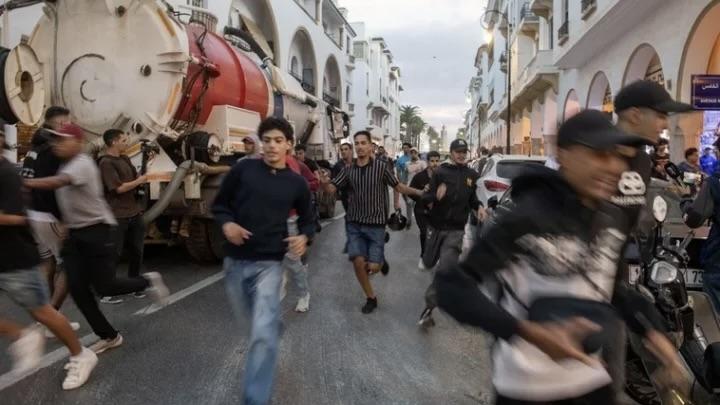
Protesters in Morocco. Photo via Izquierda Diario
In parallel, a pattern of protest emerges which, with a generational accent, shares repertoires and grievances even if the local semantics differ. In Morocco, high costs of living, youth unemployment and sectoral conflicts – especially in education – feed intermittent waves combining strikes, boycotts, and digital performativities. In Serbia, distrust in electoral integrity and fatigue with corruption reopen the street as a space of public verification.
In Nepal, restrictions on platforms and internet shutdowns act as a spark for distributed coordination and, paradoxically, intensify the politicization of mobile life. In the Philippines, transport conflict (jeepneys) condenses precarity and unpopular reforms. In Bangladesh, the legacy of student mobilizations left organizational capacities that today reappear in new controversies.
In Cameroon, “automatic democracy” – including selective blackouts – passed from indifference to protest. In Kenya, the fiscal revolt of urban youth reconfigured the political field and left a trail of structural distrust.
In Madagascar, the combination of power outages, inflation, and erosion of institutional legitimacy pushes high-rotation outbursts; and in Indonesia, complaints about privileges, opacity and regulatory shields of elites catalyze the convergence between students, workers and precarized middle layers.
The Andean corridor replicates this grammar with its own inflections: Peru sustains a cycle of mobilizations that alternate between capital and regions, organized around demands for effective representation, rights guarantees and the rejection of state violence; Ecuador, on the other hand, enters into a prolonged national strike articulated to the withdrawal of fuel subsidies and rising transport costs, with increasingly securitized responses.
The common element is not a homogeneous ideology but a material-moral equation: inflation and tariffs, unequal access to essential services, widespread perceptions of corruption or institutional privilege, and a platform regime that enables low-intensity organizational coordination and high-intensity affective mobilization.
Generation Z appears as a catalyst rather than the sole subject: it works with memetic tools, builds horizontal legitimacies and moves in hybrid geographies – the city, the feed, the group – where the speed of framing circulation surpasses the response capacity of traditional apparatuses.
Elites, by contrast, tend to read the phenomenon in securitarian or technocratic keys, producing a disjunction between core demands (income, services, representation) and surface responses (control, communication, marketing), widening the trust gap and feeding new cycles of mobilization.
Argentina inserts itself into this conjunction with a risky bet: stabilize with external anchors that bring explicit and implicit conditionalities. The narrative of the “rescue” – liquidity, currency purchases, financial vehicles – tends to consolidate as economic and geopolitical tutelage, at the same time as margins of autonomy in forums and emerging technological chains are relinquished.
The equation is known: nominal short-term predictability in exchange for prolonged dependency, declared modernization with effective primary-commodity dependence, and a management of conflictivity that oscillates between the pedagogy of sacrifice and the outsourcing of order.
What ties all these scenes together is the recomposition between finance, coercion, and technology. The geopolitical dispute is therefore fought both on territory and on perception: over critical infrastructures and, at the same time, over attention and memory; with sanctions and aircraft carriers, but also with algorithms and informational blackouts.
“The time is out of joint” does not inaugurate a slogan but a diagnosis: time has come off its hinges and the realm no longer recognizes its pivot. Without promises or reasons, that misalignment nonetheless opens the crack of another name of time: the Greek kairos, the just and opportune moment, a rare coincidence between conjuncture and the sense of historical moment. The dislocation is at once the possibility of posing a new order.
This was first published in Spanish at El Tiempo Argentina.
Courtesy: Peoples Dispatch
Get the latest reports & analysis with people's perspective on Protests, movements & deep analytical videos, discussions of the current affairs in your Telegram app. Subscribe to NewsClick's Telegram channel & get Real-Time updates on stories, as they get published on our website.









